The phrase “Portugal I Am the Village Painting” may evoke imagery of picturesque landscapes, vibrant cultural scenes, and the deep artistic heritage of Portugal. This concept resonates deeply with the soul of Portuguese art and culture, encapsulating the nation’s rich history and the essence of its traditional rural life. Let us explore the meaning, background, and artistic significance of this intriguing theme.
The Essence of “I Am the Village Painting”
The concept of “I Am the Village Painting” likely draws inspiration from a blend of traditional Portuguese folk art, modern interpretations of village life, and personal narratives of artists who seek to preserve their roots. This theme embodies a profound connection between art and community, where villages and their vibrant cultures become the canvas for emotional and historical storytelling.
In Portugal, rural villages are often seen as the heart of the nation. They preserve the essence of simplicity, where traditions and familial bonds thrive. The theme mirrors this ethos, portraying life in these villages through vivid colors, intricate patterns, and symbolic representations.
Portugal’s Artistic Heritage and Village Life
Portugal’s artistic landscape is as diverse as its geography. From the rugged cliffs of the Algarve to the rolling hills of Alentejo, the country’s villages have inspired countless artists. These small communities often serve as the backbone of Portuguese art, where local traditions and folklore merge with modern creativity.
Traditional Portuguese Art
Portugal’s traditional art forms, such as azulejos (decorative ceramic tiles), reflect its historical and cultural richness. In rural settings, these tiles often tell stories of daily life, agricultural practices, and religious devotion. The themes of these artworks often resonate with “I Am the Village Painting,” as they highlight the beauty and resilience of village life.
Modern Interpretations
Modern Portuguese artists, like Paula Rego, have taken inspiration from village life to craft pieces that delve into complex emotions and societal issues. The juxtaposition of traditional aesthetics with contemporary themes bridges the past and present, creating a dialogue that resonates globally.
Symbolism in Village Paintings
Paintings that embody the “I Am the Village” ethos often carry rich symbolism. Every element, from the choice of colors to the depiction of figures and landscapes, conveys a deeper meaning:
- Vivid Colors: Portuguese village paintings are often rich with bold blues, yellows, and greens, symbolizing the natural beauty of the countryside and the vibrant energy of its people.
- Figures and Characters: Depictions of farmers, fishers, and artisans highlight the hardworking spirit of rural communities. These figures often represent resilience and unity.
- Architectural Motifs: Whitewashed houses with terracotta roofs, cobblestone streets, and ornate chapels serve as recurring motifs, anchoring the artwork in the distinct visual identity of Portuguese villages.
- Nature and Landscape: Rolling vineyards, olive groves, and the ever-present Atlantic Ocean find their way into many works, emphasizing the harmonious relationship between nature and rural life.
Cultural Significance
The “Portugal I Am the Village Painting” theme transcends mere artistic expression. It serves as a cultural preservation tool, capturing the traditions, values, and stories of rural Portugal for future generations. This cultural preservation is vital in an era of rapid urbanization, where rural identities are at risk of fading.
Festivals and Traditions
Portuguese villages are known for their lively festivals, such as the Festas de Santo António or the Festa das Flores. These celebrations often inspire artwork, showcasing scenes of communal joy, traditional attire, and religious ceremonies.
Oral Histories in Art
Many village paintings incorporate elements of oral storytelling, visually narrating tales passed down through generations. Artists often use their work to pay homage to these stories, blending folklore with personal memories.
Notable Artists and Works
Several Portuguese artists have captured the essence of village life in their paintings, contributing to the thematic richness of “I Am the Village Painting.”
Amadeo de Souza-Cardoso
A pioneer of modernist art in Portugal, Souza-Cardoso often infused his works with the dynamism of rural life. His vibrant, abstract representations evoke the energy and rhythm of village communities.
Paula Rego
Known for her narrative style, Paula Rego draws inspiration from Portuguese folklore and rural stories. Her works often feature strong, emotional themes, intertwining the personal and cultural.
José Malhoa
As one of Portugal’s most celebrated realist painters, Malhoa is renowned for his depictions of rural life. His masterpiece “Fado” captures the melancholy and soul of Portuguese tradition, resonating with the “I Am the Village Painting” theme.
The Role of Tourism and Modern Appreciation
The concept of “Portugal I Am the Village Painting” also intersects with tourism. Portugal’s villages have become iconic destinations for travelers seeking authenticity. Artists often find inspiration in this influx, creating works that reflect the evolving identity of these communities.
Art Galleries and Exhibitions
Numerous galleries across Portugal, such as the Museu Nacional de Arte Antiga in Lisbon, host exhibitions that celebrate rural themes. These events attract art enthusiasts and serve as platforms for emerging artists to showcase their interpretations of village life.
Public Murals and Street Art
In recent years, public murals have become a vibrant expression of village identity. Towns like Covilhã and Óbidos have embraced street art, transforming their walls into large-scale canvases that narrate local stories.
Educational and Community Initiatives
The appreciation for “Portugal I Am the Village Painting” extends beyond the art world into education and community engagement. Art workshops, heritage programs, and cultural festivals play a crucial role in nurturing this theme.
- Art Workshops: Initiatives like community painting classes encourage locals to express their connection to their heritage through art.
- Heritage Programs: Organizations often collaborate with artists to document and preserve village stories, ensuring they remain part of Portugal’s cultural fabric.
Global Influence and Recognition
Portugal’s village-inspired art has gained international acclaim, influencing artists and collectors worldwide. The universality of themes like community, resilience, and harmony with nature makes these works resonate far beyond Portugal’s borders.
Exhibitions Abroad
Portuguese artists have showcased their village-inspired works in prominent galleries and museums globally, bringing a piece of rural Portugal to the world stage.
Art as a Bridge
Through their work, artists create a bridge between rural and urban, traditional and modern, local and global. This connection fosters a deeper appreciation for the beauty and significance of village life.
Conclusion
Portugal I Am the Village Painting is more than just an artistic theme; it is a celebration of identity, heritage, and the timeless beauty of rural life. By preserving the stories and traditions of Portugal’s villages, this art form serves as a cultural treasure, inspiring generations to connect with their roots and embrace the richness of their history.
Whether through traditional tiles, modern canvases, or public murals, the essence of village life continues to shine, painting a vivid picture of Portugal’s heart and soul.






